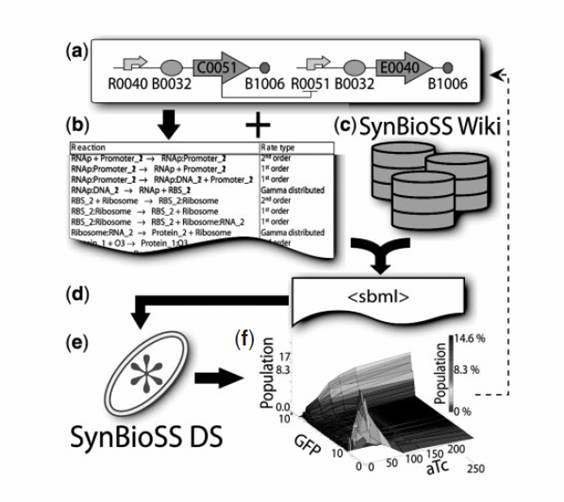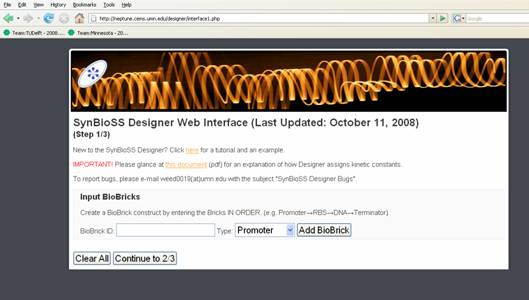Team:Minnesota/Designer
From 2009.igem.org
| Line 18: | Line 18: | ||
The entire software suite can be found via the SynBioSS [http://synbioss.sourceforge.net home page], or the [http://partsregistry.org/Image:Synbioss-1.0.2.zip Registry]. The software suite is open source that runs on Windows, Macintosh and Linux. It does not require command-line programming and thus facilitates the modeling of biochemical reactions. | The entire software suite can be found via the SynBioSS [http://synbioss.sourceforge.net home page], or the [http://partsregistry.org/Image:Synbioss-1.0.2.zip Registry]. The software suite is open source that runs on Windows, Macintosh and Linux. It does not require command-line programming and thus facilitates the modeling of biochemical reactions. | ||
| + | <h2>Future Designer</h2> | ||
A detailed, draft specification for the next version of SynBioSS can be found [http://partsregistry.org/Image:Future_SynBioSS.pdf here]. | A detailed, draft specification for the next version of SynBioSS can be found [http://partsregistry.org/Image:Future_SynBioSS.pdf here]. | ||
Revision as of 18:52, 20 October 2009
| Home | The Team | The Project | SynBioSS Designer | Modeling | Experimental | Competition Requirements |
|---|
SynBioSS
The entire software suite can be found via the SynBioSS [http://synbioss.sourceforge.net home page], or the [http://partsregistry.org/Image:Synbioss-1.0.2.zip Registry]. The software suite is open source that runs on Windows, Macintosh and Linux. It does not require command-line programming and thus facilitates the modeling of biochemical reactions.
Future Designer
A detailed, draft specification for the next version of SynBioSS can be found [http://partsregistry.org/Image:Future_SynBioSS.pdf here].
|
Introduction
What is SynBioSS good for? Going from a BioBrick number to time profiles of probability distributions of molecules. An doing this quickly: users enter BioBrick numbers and the software pulls DNA sequence information from the Registry, then builds a network of reactions that represent all the biomolecular interactions, then simulates the network of reactions in time and generates probability distributions of molecules, such as GFP.
SynBioSS is made of three components: Desktop Simulator, Designer, and Wiki. The graduate students and postdoctoral fellows in the Kaznessis lab have been developing the algorithms for stochastic simulations of gene regulatory networks. They have packaged those with a user-friendly GUI in SynBioSS Desktop Simulator.
Designer and Wiki are developed entirely by iGEM team undergraduate students (really, the graduate students don't know Python, PHP, or Javascript). Last year we developed the first version of these tools, which were stand-alone. This year we are developing and documenting SynBioSS Designer and SynBioSS wiki as new technical standards that support the design of BioBrick Parts or Devices, the construction of BioBrick Parts or Devices, the characterization of BioBrick Parts or Devices, and the analysis, modeling, and simulation of BioBrick Parts or Devices. This is occurring thanks to the connection with the BioBrick database. We are writing all kinds of scripts to fetch useful BioBrick information from the database to any user's desktop.
Imagine having a software tool that can build and simulate gene regulatory networks for you with minimal input. Just enter the IDs of the BioBricks in your system and SynBioSS will generate an SBML or NetCDF file of all the molecular biology dogma interactions: transcription, translation, regulation, degradation, and induction. Use Wiki to populate the kinetic constants and take this file to conduct sophisticated simulations of the dynamics of your synthetic construct.
Voila! From Biobrick IDs to distributions of protein molecules in a cell population.
All of our codes are made publicly available with Open Licenses.
SynBioSS Designer
SynBioSS Designer is an application for the automatic generation of sets of biomolecular reactions. This software allows a user to input the molecular parts involved in gene expression and regulation (e.g. promoters, transcription factors, ribosomes, etc.) The software then generates complete networks of reactions that represent transcription, translation, regulation, induction and degradation of those parts. To facilitate the creation of detailed kinetic models of synthetic gene networks composed of BioBricks, we have adapted SynBioSS Designer to automatically generate a kinetic model from a construct composed entirely of BioBricks. A NetCDF or SBML file is generated for simulations.
Our goal for this year's iGEM competition was to overhaul the user interface for the SynBioSS Designer. Previously, the user needed to manually input all information about every BioBrick (e.g. for promoters, the user had to input whether the promoter is constitutively on or off, whether the promoter has operator sites, where these operator sites are located, etc.). Designer is now able to interface with the Standard Biological Parts Web Service, an online database hosted by Google and populated by an RSS feed of BioBricks and their features coming directly from the Official Parts Registry. In addition to the custom-built bricks that were previously the only way of submitting BioBrick specifcations to Designer, users may now pull all relevant properties of any BioBrick automatically using only the brick ID, making Designer significantly faster and easier to use. This is especially useful when adding long sequences of bricks, especially those which constitute composite bricks. The progress on this front is capped by an updated appearance for Designer's sequence construction step, which displays the BioBricks visually (with [http://openwetware.org/wiki/Endy:Notebook/BioBrick_Open_Language_Specification vBOL symbols]) in a user-friendly and dynamic tabbed interface.
Additionally, we sought to leverage the versatility afforded us by the Standard Biological Parts Web Service to integrate a search box that would allow users to query the BioBricks database and retrieve relevant characteristics. Once completed, users will be able to search the Registry for BioBricks that fit search parameters (such as operator sites on promoters, or proteins produced by Coding DNA) and pull them into the convenient and user-friendly interface in SynBioSS. Though this project was not accomplished in full, an embryonic version of a Coding DNA search is already integrated into the live version of Designer, and hopes are high for future development.
Finally, we also adapted the software to handle polycistronic brick sequences.
Eugene
The 2009 Berkeley Software team is developing a forward engineering DNA assembly language called [http://sourceforge.net/projects/eugene/ Eugene]. BOL is a human writeable language designed to describe standard biological parts, devices, and systems, thereby facilitating communication of biological designs between members of the bioengineering community. In an effort to support this language as a new technical standard, SynBioSS Designer Designer can accept Eugene as input, as well as output any networks created (or edited) in Designer as Eugene if a user so desires.
SynBioSS Wiki
The inaccessibility of requisite kinetic data complicates the generation of detailed mechanistic models. We address this barrier by creating a web accessible database curated by users in a “Wiki” format. SynBioSS Wiki is a significant extension of the open-source Mediawiki software. The Wiki stores reaction kinetic data in a formatted and searchable scheme with references to the relevant literature. This framework allows for the input of reactions whose rates are described either by elementary first & second order rate equations or any arbitrarily complex rate equation defined using MathML (e.g. Hill type reactions). Reactions may be searched via participating molecules which may be proteins, DNA sequences, small molecules, etc. Once located, reactions of interest (along with their associated kinetic data) may be collected. The completed model may be exported in SBML format for additional editing or simulation.
It is also through the SynBioSS Wiki databases that SynBioSS Designer can access and proliferate kinetic information related to the simulation of BioBricks, thus extending the utility of the database for the benefit of the greater modeling community. To jumpstart the process, we have entered the known biomolecular interactions in the expression and regulation of well-studied operons, such as the lactose, the tetracycline and the arabinose operons.
Contributors
Developers
The following individuals have directly aided in the development of SynBioSS by writing code or assisting with other technical matters.
Undergraduates
- Emma Weeding (2006 - present)
- Jason Houle (2009 - present)
- Matthew Theisen (2008 - present)
- Chelsea Worstall (2007)
Graduate Students and Post-Docs
- Jonathan Tomshine (2006 - 2009)
- Tony Hill (2006 - 2008)
Users
The following individuals have not done any programming for SynBioSS, but offered valuable feedback by using and/or testing its components. Thank you!
- John Barrett
- Yiannis Kaznessis
- Vassilios Sotiropoulos
- Poonam Srivastava
- Ben Swiniarski
- Kat Volzing
 "
"


